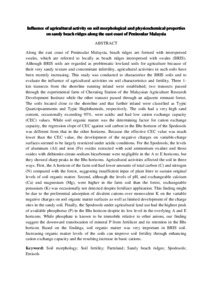Citation
Mohd Yusoff, Khairul Hafiz and Abdu, Arifin and Sakurai, Katsutoshi and Tanaka, Sota and Kang, Yumei
(2017)
Influence of agricultural activity on soil morphological and physicochemical properties on sandy beach ridges along the east coast of Peninsular Malaysia.
Soil Science and Plant Nutrition, 63 (1).
55 - 66.
ISSN 0038-0768; ESSN: 1747-0765
Abstract
Along the east coast of Peninsular Malaysia, beach ridges are formed with interspersed swales, which are referred to locally as beach ridges interspersed with swales (BRIS). Although BRIS soils are regarded as problematic lowland soils for agriculture because of their very sandy texture and concomitant infertility, agricultural activities in such soils have been recently increasing. This study was conducted to characterize the BRIS soils and to evaluate the influence of agricultural activities on soil characteristics and fertility. Three 1-km transects from the shoreline running inland were established; two transects passed through the experimental farm of Cherating Station of the Malaysian Agriculture Research Development Institute while the other transect passed through an adjacent remnant forest. The soils located close to the shoreline and that further inland were classified as Typic Quartzipsamments and Typic Haplohumods, respectively. The soils had a very high sand content, occasionally exceeding 95%, were acidic and had low cation exchange capacity (CEC) values. While soil organic matter was the determining factor for cation exchange capacity, the regression slope of CEC against soil carbon in the Bhs horizon of the Spodosols was different from that in the other horizons. Because the effective CEC value was much lower than the CEC value, the development of the negative charges on variable-charge surfaces seemed to be largely restricted under acidic conditions. For the Spodosols, the levels of aluminum (Al) and iron (Fe) oxides extracted with acid ammonium oxalate and those oxides with dithionite-citrate-sodium bicarbonate were negligible in the A to E horizons, but they showed sharp peaks in the Bhs horizons. Agricultural activities affected the soil in three ways. First, the A horizon of the farm soil had lower amounts of total carbon (C) and nitrogen (N) compared with the forest, suggesting insufficient input of plant litter to sustain original levels of soil organic matter. Second, although the levels of pH, and exchangeable calcium (Ca) and magnesium (Mg), were higher in the farm soil than the forest, exchangeable potassium (K) was occasionally not detected despite fertilizer application. This finding might be due to the preferential adsorption of divalent cations over monovalent K on the variable negative charges on soil organic matter surfaces as well as limited development of the charge sites in the sandy soil. Finally, the Spodosols under agricultural land use had the highest peak of available phosphorus (P) in the Bhs horizon despite its low level in the overlying A and E horizons. While phosphate is known to be immobile relative to other anions, our finding suggest the downward translocation of mineral P from fertilizer and its retention in the Bhs horizon. Based on the findings, soil organic matter was very important in BRIS soil. Increasing organic matter levels of the soils can improve soil fertility through enhancing cation exchange capacity and the resulting increase in basic cations.
Download File
![[img]](http://psasir.upm.edu.my/62155/1.hassmallThumbnailVersion/Influence%20of%20agricultural%20activity%20on%20soil%20morphological%20and%20physicochemical%20properties%20on%20sandy%20beach%20ridges%20along%20the%20east%20coast%20of%20Peninsular%20Malaysia.pdf)  Preview |
|
Text
Influence of agricultural activity on soil morphological and physicochemical properties on sandy beach ridges along the east coast of Peninsular Malaysia.pdf
Download (85kB)
| Preview
|
|
Additional Metadata
Actions (login required)
 |
View Item |

